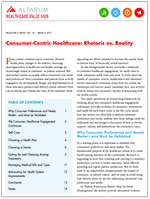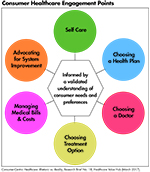Consumer-Centric Healthcare
Resources
Across stakeholders and across political affiliation, health reform is always cast as being about the patient. From consumer-directed healthcare, to shared decision-making, to consumer assistance, what does it mean to really address consumers’ needs and preferences? How can we elevate the voice of the consumer and validate that this voice is one consumers trust to represent their interests?
To bring rigor to today’s healthcare debate, we provide an overarching framework for thinking about consumers’ touch points with respect to healthcare and provide evidence on consumers’ wants and needs for each, with discussion of how to amplify and support the consumer voice.
As our issue brief shows, there are numerous resources to help us understand consumers wants and needs. Below we list a few of our favorites and we welcome your additions.
General Resources
- Consumer-centric Healthcare: Rhetoric vs. Reality, Healthcare Value Hub
This research brief highlights research on consumer preferences and needs in regards to the healthcare system, how the system fails to meet these preferences and needs, and how the system can better serve their patients. The research is divided into the different phases of consumer interaction including; self-care, choosing a health plan, choosing a doctor, opting for and choosing among treatments, managing medical bills and costs and advocating for health system improvements.
- Carman, Kristin, et al., "Patient and Family Engagement: A Framework for Understanding the Elements and Developing Interventions and Policies," Health Affairs, Vol. 32, No. 2 (February 2013).
Choosing a Health Plan
-
Choosing a health plan is hard, even for a health economist, Austin Frakt
-
People are bad at choosing health plans, and they don’t even know it, Austin Frakt
-
What’s Behind the Door: Consumer Difficulties Selecting Health Plans, Consumers Union, 2012
-
The Evidence Is Clear: Too Many Health Insurance Choices Can Impair, Not Help, Consumer Decision Making, Consumers Union, 2012
-
Loewenstein, George, et al., "Consumers' Misunderstanding of Health Insurance," Journal of Health Economics, 32, no. 5 (September 2013): 850–862.
Choosing a Doctor
-
Deloitte. Findings from Deloitte’s 2016 consumer priorities in health care survey. 2016
-
Engaging Consumers on Healthcare Cost and Value Issues, Consumers Union, 2014
Choosing Among Treatment Options
-
Carman, Kristin, et al., "Understanding an informed public’s views on the role of evidence in making health care decisions," Health Affairs, Vol. 35, No. 4 (April 2016).
-
Sommers, et al., "Focus groups highlight that many patients object to clinicians' focusing on costs," Health Affairs, Vol. 32, No. 2 (February 2013).
Getting Consumer Voice to Policymaking and Program Tables
-
Experiences of Consumers with Managed Long-Term Services and Supports Programs: Insights from Dual Eligible Enrollees in Massachusetts and Ohio, Community Catalyst
-
Meaningful Consumer Engagement Toolkit, Community Catalyst
-
State Innovation Model (SIM) Grants: A Scorecard for Consumer Advocate Engagement, Families USA








